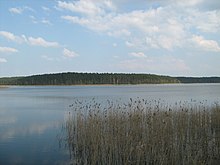Ostrów (Stare Juchy)
| Ostrów | ||
|---|---|---|

|
|
|
| Basic data | ||
| State : | Poland | |
| Voivodeship : | Warmia-Masuria | |
| Powiat : | Ełk | |
| Gmina : | Stare Juchy | |
| Geographic location : | 53 ° 51 ' N , 22 ° 3' E | |
| Residents : | 77 (March 31, 2011) | |
| Postal code : | 19-324 | |
| Telephone code : | (+48) 87 | |
| License plate : | NEL | |
| Economy and Transport | ||
| Street : | Skomack Wielki → Ostrów | |
| Pańska Wola - Pańska Wola (osada) → Ostrów | ||
| Rail route : | no rail connection | |
| Next international airport : | Danzig | |
Ostrów [ ˈɔstruf ] ( German Werder ) is a place in the Polish Warmian-Masurian Voivodeship , which belongs to the rural community of Stare Juchy (Alt Jucha , 1938 to 1945 Fließdorf) in the powiat Ełcki ( Lyck district ).
Geographical location
Ostrów is located on the north bank of the Jezioro Orzysz ( German Aryssee ) in the southeast of the Warmian-Masurian Voivodeship. It was 29 kilometers to the former district town of Lötzen (Polish: Giżycko), today's district metropolis of Ełk (Lyck) is 19 kilometers to the east.
history
The small Gutsdorf around 1785 Ostrow , before 1912 Adlig Werder , until 1945 Werder (without additional designation), was added in 1874 to the newly established administrative district of Neuhoff ( Zelki in Polish ), which existed until 1945 and to the district of Lötzen in the administrative district of Gumbinnen (1905 to 1945 : Olsztyn administrative district ) in the Prussian province of East Prussia . Also in 1874 the village was included in the Neuhoff registry office district . In 1905 the Adlig Werder manor district had 65 inhabitants.
Due to the provisions of the Versailles Treaty , the population in the Allenstein voting area , to which Werder belonged, voted on July 11, 1920 on whether it would continue to belong to East Prussia (and thus to Germany) or join Poland. In Werder, 40 residents voted to remain with East Prussia, Poland did not receive any votes.
On September 30, 1928 the Gutsdorf Werder gave up its independence and was incorporated into the rural community Adlig Wolla (1938 to 1945 Freihausen, Polish Pańska Wola).
As a result of the war, Werder came to Poland in 1945 along with all of southern East Prussia and was given the Polish name “Ostrów”. Today the village is part of the Schulzenamt ( Polish sołectwo ) Skomack Wielki (Skomatzko , 1938 to 1945 Dippelsee) and thus a place in the network of the rural community Stare Juchy (Alt Jucha , 1938 to 1945 Fließdorf) , from the district of Lötzen into the powiat Ełcki ( Lyk district ) "changed", and before 1998 the Suwałki Voivodeship , since then part of the Warmian-Masurian Voivodeship .
Religions
Until 1945 Werder was parish in the Protestant Church of Neuhoff in the church province of East Prussia, the Church of the Old Prussian Union, and in the Catholic parish church of St. Bruno Lötzen in the Diocese of Warmia .
Today Ostrów belongs to the Protestant parish Ełk (Lyck) , a branch parish of the parish Pisz (Johannisburg) in the diocese of Masuria of the Evangelical Augsburg Church in Poland and to the Catholic parish Skomack Wielki (Skomatzko , 1938 to 1945 Dippelsee) , a branch of the parish Klusy (Klaussen) in the Diocese of Ełk of the Roman Catholic Church in Poland .
traffic
Ostrów can be reached via a side road from Skomack Wielki , as well as a country road that leads from Pańska Wola (Adlig Wolla , 1938 to 1945 Freihausen) to here.
Until the closure of the railway line Czerwonka – Ełk (Rothfließ – Lyck) in 2009 Skomack Wielki was the next station.
Individual evidence
- ^ CIS 2011: Ludność w miejscowościach statystycznych według ekonomicznych grup wieku , March 31, 2011, accessed on April 21, 2019 (Polish).
- ↑ Polish Postal Code Directory 2013, p. 889
- ^ Dietrich Lange, geographical register of places in East Prussia (2005): Werder
- ^ Rolf Jehke, Neuhoff district
- ↑ a b c Werder (district of Lötzen)
- ↑ Herbert Marzian , Csaba Kenez : self-determination for East Germany. Documentation on the 50th anniversary of the East and West Prussian referendum on July 11, 1920. Editor: Göttinger Arbeitskreis , 1970, p. 82
- ^ Walther Hubatsch , History of the Protestant Church in East Prussia , Volume 3 Documents ; Göttingen, 1968, p. 492


